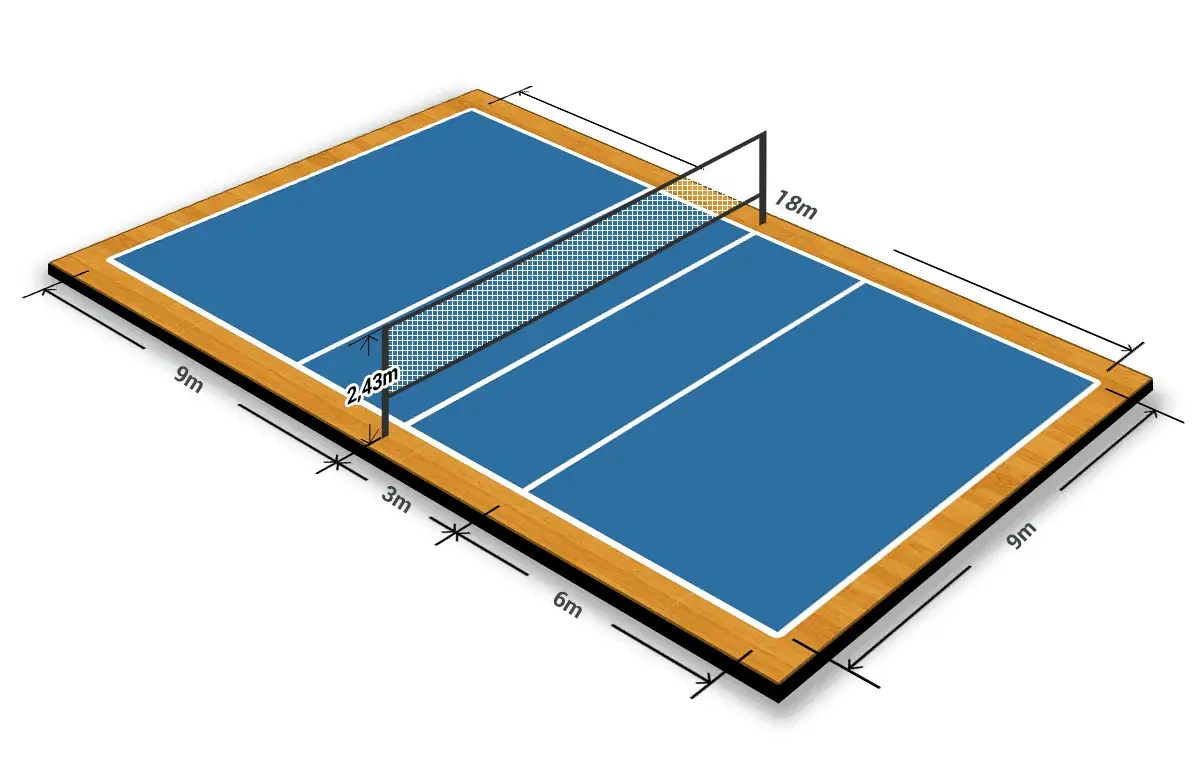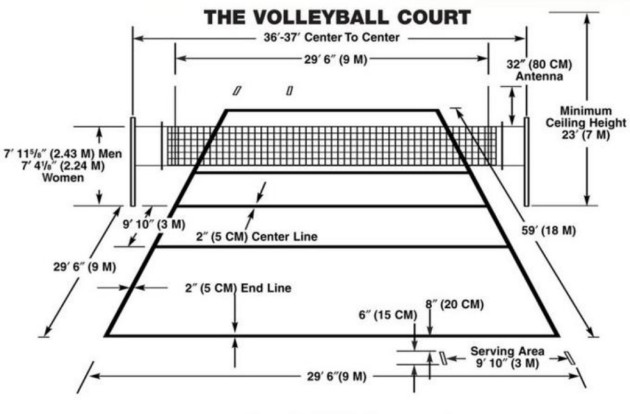Size Of Regulation Volleyball Court
The size of a regulation volleyball court is an important factor in determining the level of play and ensuring fair competition. In this article, we will explore the dimensions of a volleyball court, including the net size and height. Whether you are a player, coach, or simply a fan of the sport, understanding these measurements can deepen your appreciation for the game. So, let's jump right in!
Regulation Volleyball Court Dimensions
A regulation volleyball court is rectangular in shape and measures 18 meters long by 9 meters wide. The court is divided into two equal halves by a net that stands 2.43 meters high for men's competitions and 2.24 meters high for women's competitions. The net is attached to two sturdy posts, one on each side of the court, and extends vertically from the ground to the specified height. It is essential to maintain these dimensions to ensure a fair and competitive game.

The above image illustrates a regulation volleyball court with the net dividing it into two halves. It showcases the dimensions and provides a visual reference for players and enthusiasts.
Net Size and Material
The net used in professional volleyball competitions consists of mesh fabric that allows the ball to pass through. The standard width of the net is approximately 1 meter, which is attached to the posts on either side of the court. One important aspect of the net is its tension, which should be consistent throughout the game. A properly tensioned net helps prevent the ball from bouncing off or getting caught in it, ensuring a smooth and fair gameplay experience.

The image above demonstrates a close-up shot of the net and its tension. Note how the mesh is stretched uniformly, avoiding any sags or loose areas.
Height of the Net
The height of the net is an important aspect that distinguishes men's and women's volleyball competitions. For men's volleyball, the net is set at a height of 2.43 meters (or approximately 7 feet 11 5/8 inches). This height accommodates the increased vertical jumping abilities of male athletes. On the other hand, the net is set at a slightly lower height of 2.24 meters (or approximately 7 feet 4 1/8 inches) for women's volleyball competitions.
By adjusting the net's height based on gender, the game remains fair and allows players to showcase their skills and athleticism while maintaining a level playing field.
Importance of Regulation Court Size
Playing on a regulation-sized court is crucial for several reasons. Firstly, it ensures consistency across different competitions and venues. When athletes train and compete on standardized courts, they develop a better sense of their surroundings, allowing them to make precise moves and plays with confidence.
Additionally, a regulation-size court encourages fair play by offering equal opportunities for both teams. The court's dimensions play a significant role in the strategies and tactics employed by players. Familiarity with the court's length and width is essential in executing accurate serves, setting up plays, and maintaining proper positioning during the game.
Listicle: Tips to Improve Your Volleyball Game
Master Your Serve

The serve is the essential start to each rally in volleyball. To improve your serve, focus on consistency and accuracy. Practice different serving techniques, such as the float serve, jump serve, or topspin serve, to keep your opponents guessing. A powerful and well-placed serve can put your team at an immediate advantage.
Enhance Your Passing Skills

Passing, or the act of successfully receiving and directing the ball, is a fundamental skill in volleyball. Work on your footwork, body positioning, and hand placement to improve your passing accuracy. Additionally, communicate with your teammates to ensure seamless coordination during passing plays.
Develop Your Spiking Technique

The spike is a powerful offensive move that can score valuable points for your team. Focus on timing, approach, and arm swing technique to execute a successful spike. Practice varying your spike angles and speeds to keep the opposing team's defense off-balance.
Frequently Asked Questions (FAQs)
Q: Can a volleyball court be made of different materials?
A: While the standard volleyball court is made of a high-quality and durable surface, such as synthetic sports flooring or wood flooring, in recreational settings, sand courts are also popular. Sand courts provide a unique playing experience and are commonly found at beach volleyball tournaments or recreational areas.
Q: What are the sideline and end line boundaries on the volleyball court?
A: In volleyball, the sideline boundaries are the long edges of the court, running parallel to the net. These boundaries determine whether a ball is considered "in" or "out" of play. The end line boundaries are the shorter edges of the court, perpendicular to the net. They play a similar role in determining ball placement during serves and rallies.
Q: What should be the minimum ceiling height for a volleyball court?
A: To ensure proper play and player safety, the minimum ceiling height for a volleyball court should be at least 7 meters (or approximately 23 feet). This height allows for sufficient clearance when players jump to spike or block the ball, reducing the risk of injury.
Remember, understanding the regulation size of a volleyball court, net, and height is crucial for players and enthusiasts alike. It ensures fair play, consistent competition, and a better overall experience for everyone involved. So, the next time you watch a volleyball game or step onto the court, you'll have a deeper appreciation for the dimensions that make the sport so exciting.
How Is Volleyball Played? | Set Up For Volleyball
 Image Source : setupforvolleyball.com
Image Source : setupforvolleyball.com volleyball court dimensions drawing sketch indoor beach played standard diagram line each paintingvalley highlighted halfway below side into
Medidas De La Cancha De Voleibol 2022- Dimensiones.
 Image Source : diariodealgoespecial.com
Image Source : diariodealgoespecial.com cancha voleibol dimensiones
The Standard Volleyball Court Dimensions – All Sports
 Image Source : allsportschoice.com
Image Source : allsportschoice.com volleyball court dimensions standard indoor regulation
Volleyball Court Dimensions | Warrenton Youth Sports Club
Official Volleyball Rules PART 4: Facilities And Equipment – Playing
 Image Source : worldofvolley.com
Image Source : worldofvolley.com terminology quizlet volley sand regulations meters theartofcoachingvolleyball voleibol quadra wiping worldofvolley tampar
Volleyballgericht Abmessungen Größenanleitung Vektorillustration
 Image Source : www.istockphoto.com
Image Source : www.istockphoto.com Pin Sa Software
 Image Source : www.pinterest.ph
Image Source : www.pinterest.ph Volleyball Court Dimensions, Net Size And Height | Sports Feel Good
 Image Source : www.pinterest.com
Image Source : www.pinterest.com sportsfeelgoodstories badminton
Volleyball court dimensions drawing sketch indoor beach played standard diagram line each paintingvalley highlighted halfway below side into. Pin sa software. The standard volleyball court dimensions – all sports. Medidas de la cancha de voleibol 2022- dimensiones.. Volleyball court dimensions